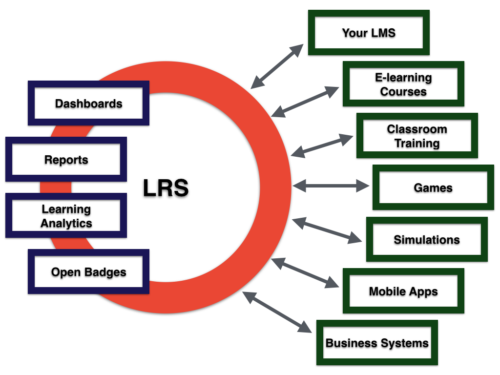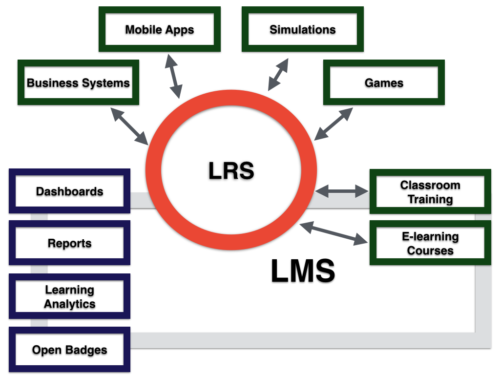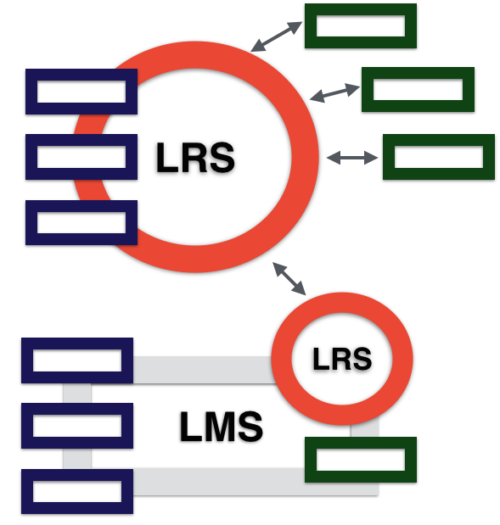Ecosystem
The Enterprise Learning Ecosystem
xAPI changes the way we think about the enterprise learning ecosystem. It’s been designed with a completely different mindset than previous learning specifications Learning happens everywhere, not just the LMS and often that learning is self directed by the learner. This requires a change in how our learning systems are organized so we can track and integrate these disparate learning experiences and then see that data alongside all of the other data that the organization collects.

The LRS as a standalone system
A new class of system, the Learning Record Store (LRS) stores data about learning experiences from a range of sources, known as Activity Providers. The LRS uses this data in dashboards, reports, learning analytics and can even award Open Badges. It also makes the data available for other systems to use.
The diagram above shows the LRS as a stand alone system, but the LRS can also be incorporated into an LMS. In this scenario, reporting and analytics may be left to the LMS to provide, using data from the LRS.

An LRS within an LMS
Even when the LRS is part of an LMS, it should still have the capability to connect to activity providers and other LRSs external to the LMS. Whether the LRS is internal to or external from an LMS, data from mobile applications, learning websites and informal learning experiences can all be brought into and used by the LRS. Even operational business systems can be made to record experiences and performance relating to job tasks, so you can correlate performance data with learning data.

Multiple LRSs can communicate with one another
Learning Record Stores are designed to communicate with one another. Many organizations choose to have an LRS embedded in their LMS to collect data from the LMS and have an external LRS to provide deeper analytics and collect data from external sources that an LMS can’t do without an LRS.
One innovative feature of xAPI is to enable the sharing of data between Learning Record Stores (LRSs). It’s possible that two LRSs, perhaps from different vendors, can be integrated together by configuration in a matter of minutes. If you’ve ever been involved in an LMS integration project and seen the work involved, you’ll realize just how groundbreaking that is. Read more about sharing statements between LRSs here.
The LMS
In the new world of xAPI, the LMS often continues its role in managing and launching formal learning materials. The LMS also plays the role of an activity provider, reporting the learner’s activity to the LRS. This goes beyond data from e-learning packages; any activity within the LMS can be tracked.
Some LMS vendors have chosen to include an LRS as part of their system whilst others allow the administrator to connect the LMS to an external LRS, allowing their customers to choose their LRS separately. If you’re an LMS vendor just making that decision now, our xAPI Impacts guide will be of interest.
Some organizations have considered replacing their LMS with a number of smaller systems integrated together via the LRS. If you’re not sure if your organizations still needs an LMS read this guide: Do I still need an LMS?.
Learning Record Store (LRS)
The LRS is the heart of any xAPI ecosystem, receiving, storing and returning data about learning experiences, achievements and job performance.
Despite the similar sounding acronyms, LRSs and LMSs are very different products. You use an LRS to store, retrieve and study data about learning experiences; you use an LMS to launch and facilitate learning experiences. These experiences might be traditional e-learning courses and formal training, or more innovative learning experiences made possible by xAPI.
In most cases learners will never see the LRS or even be aware it exists; any data relevant to them will be pulled out and displayed within a learner-facing system. Read More.
Activity Providers
An activity provider is any tool or system that generates data about learning experiences, achievements and job performance and sends it to the LRS. This represents a wide range of learning technologies from an e-learning course to an event attendance app, from a social learning platform to an interactive whiteboard. Read More
Business Systems
You can use xAPI to collect data about job performance from business systems (the equipment and software your people use to do their jobs). This data can be combined with data about learning from other activity providers to improve learning initiatives and business decisions.
When you pull data from a business system, it’s really just a type of activity provider. In this case the activity being provided is the job task being performance and the data generated is data relating to job performance.
Open Badges
The last few years have seen the rise in popularity of Open Badges. These digital credentials are awarded to learners on the basis of competency, achievement or engagement. A credentialing service uses learning experiences recorded by xAPI as evidence in order to award credentials such as Open Badges to learners.
Dashboards
Dashboards are shiney, in your face displays that tell you one or two key pieces of information about what’s going on right now. For a learner, this might be some recommended or required learning activity, their score on a recent important assessment or a link back to the last page they bookmarked. A manager’s dashboard includes aggregate information about the people they are responsible for and also shows alerts relating to actions they might need to take.
Reports
Reports give historical information about what has (or in some cases hasn’t) happened. This might be the number of learners who completed a course, a list of people who need to, or a set of scores in an assessment. Reports generally focus on a specific context, giving information about one particular activity or learner. You’ll be familiar with reports from the days of SCORM; the difference is now you can report on a much broader range of activities.
Analytics
Analytics go deeper than reports and look at the meaning behind the data. They compare and correlate data from different sources to find and test connections. Where reports tell you that the learner completed a course, analytics help you to understand the impact of that action on the learner’s performance and on your business.
Analytics go much deeper than reports and allow you to discover actionable insights that inform significant business decisions. It’s vital that you have good analytics in order to make use of the data collected with xAPI.
Next Steps
Learn more
Dive deeper into the new learning ecosystem with a recording of the Rethinking Learning Systems with the Experience API webinar.
Go more innovative!
The diagrams and explanations on this page assume that your LMS continues to play an important role in your learning ecosystem. Some organizations are starting to question that assumption. If that’s you, read more about if you still need an LMS here.
Ready to adopt?
If you’ve been reading through this site linearly, you’ve now learned about what xAPI is, why you should adopt and the ecosystem that xAPI makes possible. If you’d like to read more, you might enjoy exploring our blog and the latest xAPI related news and thoughts.
Or maybe you’re ready to Get Started?
Questions? Ask us anything.
At Rustici Software, we help hundreds of people each month with their xAPI questions. Many aren’t sales prospects; they just have questions. We’re happy to help. You can ask us anything ‒ really.